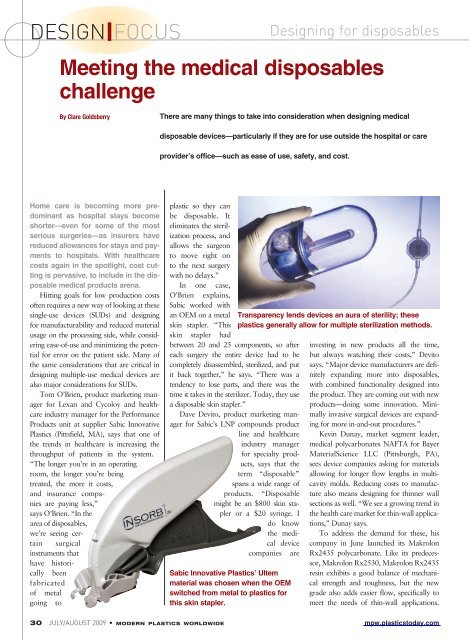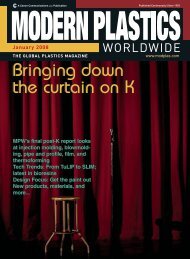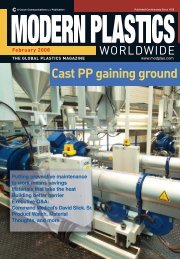Modern Plastics Worldwide - July/August 2009 - dae uptlax
Modern Plastics Worldwide - July/August 2009 - dae uptlax
Modern Plastics Worldwide - July/August 2009 - dae uptlax
You also want an ePaper? Increase the reach of your titles
YUMPU automatically turns print PDFs into web optimized ePapers that Google loves.
DESIGN|FOCUS<br />
Designing for disposables<br />
Meeting the medical disposables<br />
challenge<br />
By Clare Goldsberry<br />
Home care is becoming more predominant<br />
as hospital stays become<br />
shorter—even for some of the most<br />
serious surgeries—as insurers have<br />
reduced allowances for stays and payments<br />
to hospitals. With healthcare<br />
costs again in the spotlight, cost cutting<br />
is pervasive, to include in the disposable<br />
medical products arena.<br />
Hitting goals for low production costs<br />
often requires a new way of looking at these<br />
single-use devices (SUDs) and designing<br />
for manufacturability and reduced material<br />
usage on the processing side, while considering<br />
ease-of-use and minimizing the potential<br />
for error on the patient side. Many of<br />
the same considerations that are critical in<br />
designing multiple-use medical devices are<br />
also major considerations for SUDs.<br />
Tom O’Brien, product marketing manager<br />
for Lexan and Cycoloy and healthcare<br />
industry manager for the Performance<br />
Products unit at supplier Sabic Innovative<br />
<strong>Plastics</strong> (Pittsfield, MA), says that one of<br />
the trends in healthcare is increasing the<br />
throughput of patients in the system.<br />
“The longer you’re in an operating<br />
room, the longer you’re being<br />
treated, the more it costs,<br />
and insurance companies<br />
are paying less,”<br />
says O’Brien. “In the<br />
area of disposables,<br />
we’re seeing certain<br />
surgical<br />
instruments that<br />
have historically<br />
been<br />
fabricated<br />
of metal<br />
going to<br />
There are many things to take into consideration when designing medical<br />
disposable devices—particularly if they are for use outside the hospital or care<br />
provider’s office—such as ease of use, safety, and cost.<br />
plastic so they can<br />
be disposable. It<br />
eliminates the sterilization<br />
process, and<br />
allows the surgeon<br />
to move right on<br />
to the next surgery<br />
with no delays.”<br />
In one case,<br />
O’Brien explains,<br />
Sabic worked with<br />
an OEM on a metal<br />
skin stapler. “This<br />
skin stapler had<br />
between 20 and 25 components, so after<br />
each surgery the entire device had to be<br />
completely disassembled, sterilized, and put<br />
it back together,” he says. “There was a<br />
tendency to lose parts, and there was the<br />
time it takes in the sterilizer. Today, they use<br />
a disposable skin stapler.”<br />
Dave Devito, product marketing manager<br />
for Sabic’s LNP compounds product<br />
line and healthcare<br />
industry manager<br />
for specialty products,<br />
says that the<br />
term “disposable”<br />
spans a wide range of<br />
products. “Disposable<br />
might be an $800 skin stapler<br />
or a $20 syringe. I<br />
do know<br />
the medical<br />
device<br />
companies are<br />
Sabic Innovative <strong>Plastics</strong>’ Ultem<br />
material was chosen when the OEM<br />
switched from metal to plastics for<br />
this skin stapler.<br />
Transparency lends devices an aura of sterility; these<br />
plastics generally allow for multiple sterilization methods.<br />
investing in new products all the time,<br />
but always watching their costs,” Devito<br />
says. “Major device manufacturers are definitely<br />
expanding more into disposables,<br />
with combined functionality designed into<br />
the product. They are coming out with new<br />
products—doing some innovation. Minimally<br />
invasive surgical devices are expanding<br />
for more in-and-out procedures.”<br />
Kevin Dunay, market segment leader,<br />
medical polycarbonates NAFTA for Bayer<br />
MaterialScience LLC (Pittsburgh, PA),<br />
sees device companies asking for materials<br />
allowing for longer flow lengths in multicavity<br />
molds. Reducing costs to manufacture<br />
also means designing for thinner wall<br />
sections as well. “We see a growing trend in<br />
the health care market for thin-wall applications,”<br />
Dunay says.<br />
To address the demand for these, his<br />
company in June launched its Makrolon<br />
Rx2435 polycarbonate. Like its predecessor,<br />
Makrolon Rx2530, Makrolon Rx2435<br />
resin exhibits a good balance of mechanical<br />
strength and toughness, but the new<br />
grade also adds easier flow, specifically to<br />
meet the needs of thin-wall applications.<br />
30 JULY/AUGUST <strong>2009</strong> • MODERN PLASTICS WORLDWIDE mpw.plasticstoday.com









